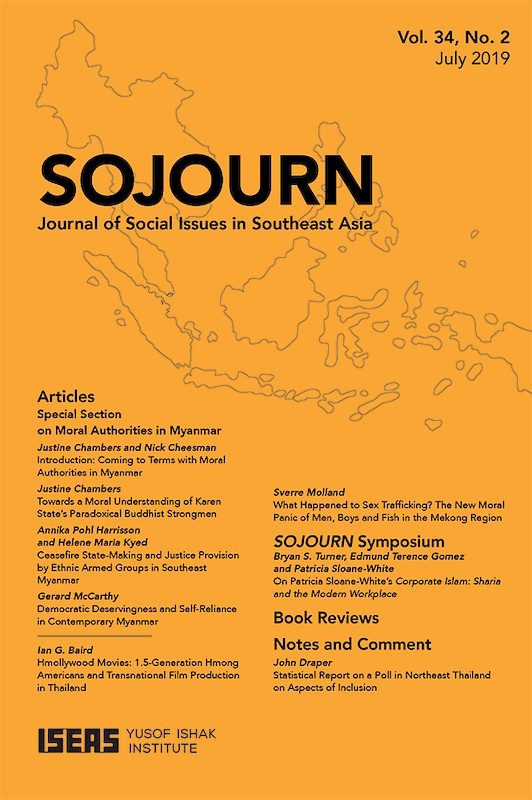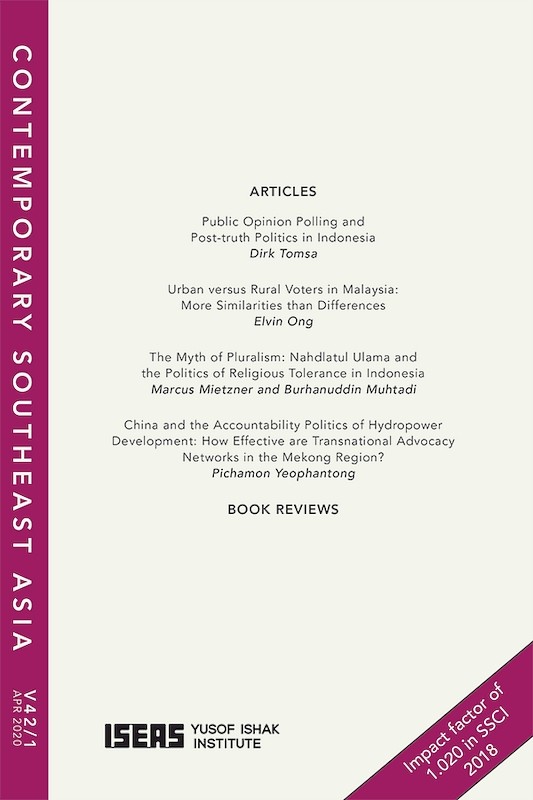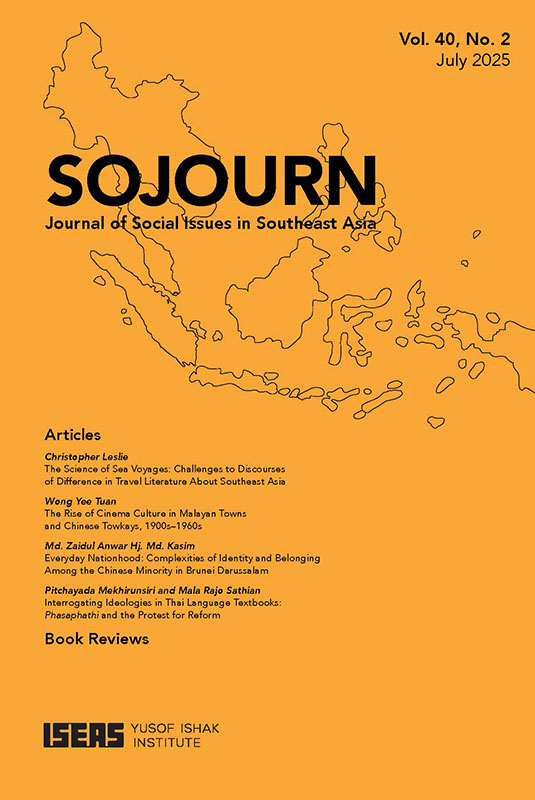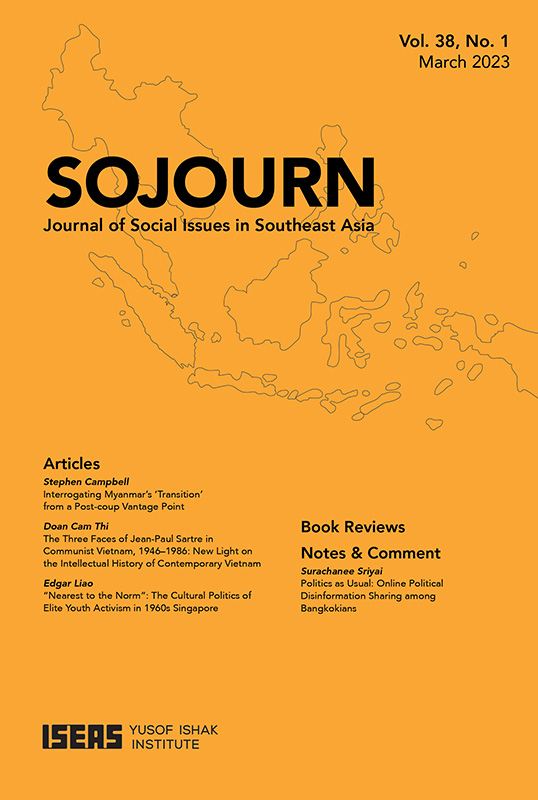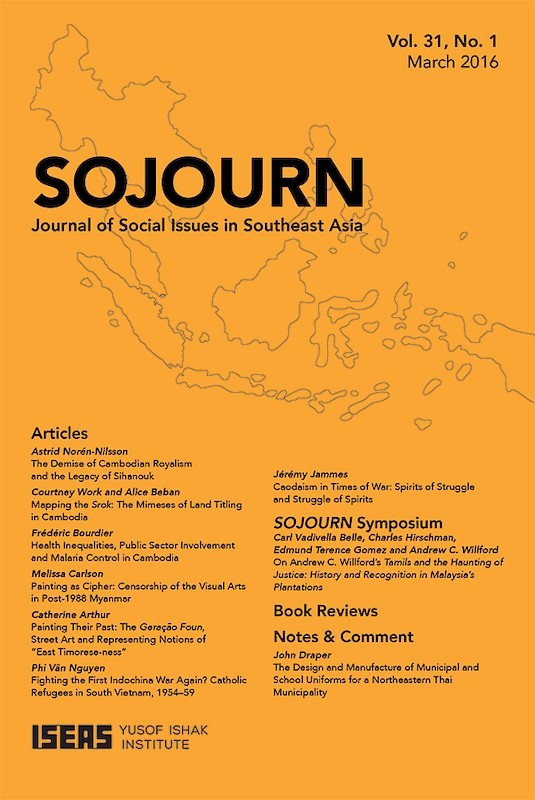SOJOURN: Journal of Social Issues in Southeast Asia Vol. 40/1 (March 2025)
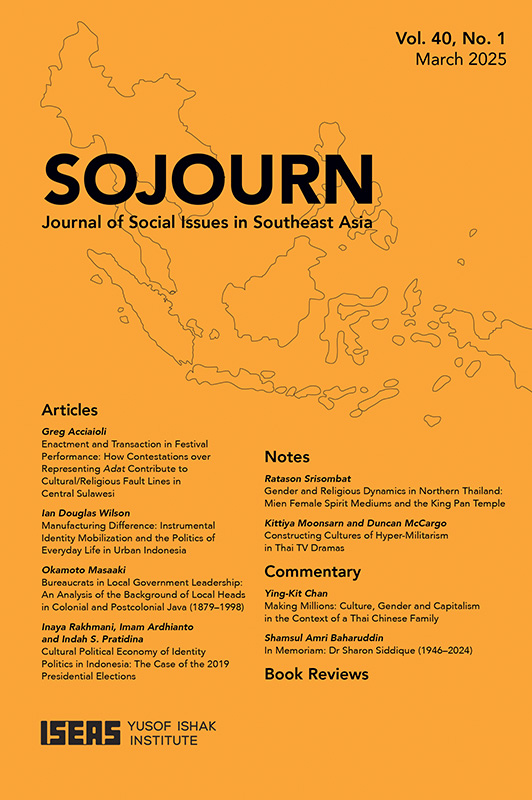
Date of publication:
February 2025
Publisher:
ISEAS – Yusof Ishak Institute
Number of pages:
187
Code:
SJ40/1
Soft Cover
ISSN: 02179520
Contents
-
SOJOURN: Journal of Social Issues in Southeast Asia Vol. 40/1 (March 2025)
[Whole Publication, ISSN: 17932858] -
Preliminary pages
- ARTICLES
-
Enactment and Transaction in Festival Performance: How Contestations over Representing Adat Contribute to Cultural/Religious Fault Lines in Central Sulawesi, by Greg Acciaioli, author see abstractThis article explores how festivals in Central Sulawesi as sites for celebrating regional heritage have emerged as a contested frame for articulation of local cultural identities as managed by the Indonesian state. While official bodies seek to aestheticize local cultures so that their (re-)presentations embody artistic values promoting national unity, local peoples often seek to display their customs in ways that can cross the border from aesthetic enactments to transactions with worldly consequences, such as actual spirit possession, which can open up cultural/religious fault lines. This article investigates the tensions occasioned by the ambiguous distinction between enactment and transaction at the Festival of Lake Lindu held in 2010 and then at the 2018 Festival Pesona Palu Nomoni, whose enactment of Kaili trance healing was blamed for the earthquake, tsunami and liquefaction that devastated the city at the festival opening.
-
Manufacturing Difference: Instrumental Identity Mobilization and the Politics of Everyday Life in Urban Indonesia, by Ian Douglas Wilson, author see abstractCommentators have often cited a deepening of identity-based social fault lines across Indonesia’s vast sociopolitical landscape. Yet the country has experienced little of the kinds of communal conflict or electoral turmoil of near neighbours in recent years. Drawing on observations of electoral politics in Jakarta, this article argues that top-down electoral polarization bears little resemblance to how identity and difference are experienced and utilized as pragmatic resources in the urban politics of the everyday. This dynamic helps to explain why the parameters of electoral polarization have dissipated post-election and failed to translate into deeper forms of societal-level conflict.
-
Bureaucrats in Local Government Leadership: An Analysis of the Background of Local Heads in Colonial and Postcolonial Java (1879–1998), by Okamoto Masaaki, author see abstractThis article aims to analyse the changing central-local government relationships in Java from the late nineteenth to late twentieth centuries. These changes allowed actors with different professional backgrounds (bureaucrats, politicians, military officers, businessmen, etc.) to emerge as local heads. One key finding is the resilience of the civilian bureaucracy in local government leadership. Since the late colonial period, bureaucrats have survived government changes and have successfully assumed a fair number of local head posts in Java. This article shows their resilience quantitatively.
-
Cultural Political Economy of Identity Politics in Indonesia: The Case of the 2019 Presidential Elections, by Inaya Rakhmani, Imam Ardhianto, Indah S. Pratidina, authors see abstractThis article uses a cultural political economy framework to interpret identity politics in Indonesia’s electoral politics by taking the case of the 2019 presidential elections. Using empirical evidence from thematically analysed mis-/disinformation, it explains how supporters of presidential candidates have consistently deployed narratives to shape specific notions of threats that undermine the nation’s unity. We see such efforts in the cultural and material forces of religion and race mobilized by the political campaign industry. This article reveals how mediated electoral narratives discursively conjure the image of a strong state that defends national sovereignty, and this image reproduces the fundamental issues of class and inequalities that neither presidential candidate can address in neoliberal times.
- NOTES
-
Gender and Religious Dynamics in Northern Thailand: Mien Female Spirit Mediums and the King Pan Temple, by Ratason Srisombat, author see abstractThis research note is focused on religious dynamics and social organization among Thailand’s Mien people. Two elements in particular have been of primary importance in Mien society and culture over the centuries: ritual practice and patriarchy. Male bias in ritual traditions seemed inevitable among the Mien. Only men became spirit mediums; women were barred from even being near ritual objects and practices. The recent emergence of female spirit mediums shows an unexpected change in tradition. As an anthropologist and a Mien woman in Thailand, I explore these dynamics by tracing the emergence of female mediums in Chiangrai Province of northern Thailand.
-
Constructing Cultures of Hyper-Militarism in Thai TV Dramas, by Kittiya Moonsarn, Duncan McCargo, authors see abstractThe military has been involved in many aspects of Thai public life, including repeated intervention in politics, participation in civil affairs, and representation in entertainment media. The military has boosted its own standing by establishing a close connection with the monarchy. By using its influence over the media to present pro-military propaganda, it promotes a culture of hyper-militarism. This article investigates the construction of the culture of hyper-militarism in Thai TV dramas based on analysis of a selection of sample dramas broadcast between 2014 and 2023. It demonstrates how a culture of hyper-militarism is constructed by reproducing positive images of the military.
- COMMENTARY
-
Making Millions: Culture, Gender and Capitalism in the Context of a Thai Chinese Family, by Ying-kit Chan, author see abstractIn 2024, a Thai film broke box office records across Southeast Asia. The film, How to Make Millions Before Grandma Dies, is set in Talat Phlu, a historic Chinese district of Bangkok. In addition to possible interpretations through cultural lenses, the film, which features intergenerational conflict and reconciliation, is a fascinating gendered critique of Chinese patriarchalism, whereby sons rather than daughters receive an inheritance among Chinese families in Thailand.
-
In Memoriam: Dr Sharon Siddique (1946–2024), by Shamsul Amri Baharuddin, author
- BOOK REVIEWS
-
BOOK REVIEW: In Asian Waters: Oceanic Worlds from Yemen to Yokohamaby Eric Tagliacozzo, by Jayde Lin Roberts, author
-
BOOK REVIEW: Disturbed Forests, Fragmented Memories: Jarai and Other Lives in the Cambodian Highlands by Jonathan Padwe, by Lisa J Arensen, author
-
BOOK REVIEW: Building on Borrowed Time: Rising Seas and Failing Infrastructure in Semarang by Lukas Ley, by Jamie S Davidson, author
-
BOOK REVIEW: Upland Geopolitics: Postwar Laos and the Global Land Rush by Michael B. Dwyer, by Holly High, author
-
BOOK REVIEW: Malaysian Crossings: Place and Language in the Worlding of Modern Chinese Literature by Cheow Thia Chan, by Show Ying Xin, author
-
BOOK REVIEW: Colonizing Animals: Interspecies Empire in Myanmar by Jonathan Saha, by Noriyuki Osada, author
-
BOOK REVIEW: Constitutional Bricolage: Thailand’s Sacred Monarchy vs. The Rule of Law by Eugénie Mérieau, by Apinop Atipiboonsin, author

